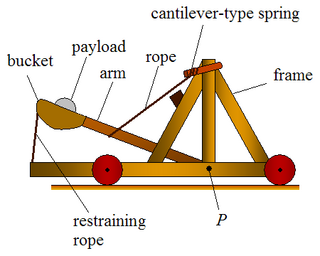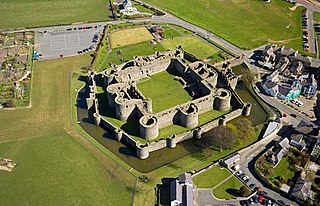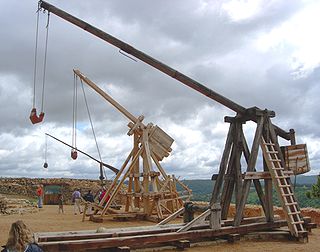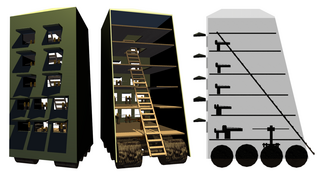
A catapult is a ballistic device used to launch a projectile a great distance without the aid of gunpowder or other propellants – particularly various types of ancient and medieval siege engines. A catapult uses the sudden release of stored potential energy to propel its payload. Most convert tension or torsion energy that was more slowly and manually built up within the device before release, via springs, bows, twisted rope, elastic, or any of numerous other materials and mechanisms.

Medieval warfare is the warfare of the Middle Ages. Technological, cultural, and social advancements had forced a severe transformation in the character of warfare from antiquity, changing military tactics and the role of cavalry and artillery. In terms of fortification, the Middle Ages saw the emergence of the castle in Europe, which then spread to the Holy Land.

Medieval fortification refers to medieval military methods that cover the development of fortification construction and use in Europe, roughly from the fall of the Western Roman Empire to the Renaissance. During this millennium, fortifications changed warfare, and in turn were modified to suit new tactics, weapons and siege techniques.

A siege is a military blockade of a city, or fortress, with the intent of conquering by attrition, or by well-prepared assault. Siege warfare is a form of constant, low-intensity conflict characterized by one party holding a strong, static, defensive position. Consequently, an opportunity for negotiation between combatants is common, as proximity and fluctuating advantage can encourage diplomacy.

A Roman siege tower or breaching tower is a specialized siege engine, constructed to protect assailants and ladders while approaching the defensive walls of a fortification. The tower was often rectangular with four wheels with its height roughly equal to that of the wall or sometimes higher to allow archers or crossbowmen to stand on top of the tower and shoot arrows or quarrels into the fortification. Because the towers were wooden and thus flammable, they had to have some non-flammable covering of iron or fresh animal skins.

A battering ram is a siege engine that originated in ancient times and was designed to break open the masonry walls of fortifications or splinter their wooden gates. In its simplest form, a battering ram is just a large, heavy log carried by several people and propelled with force against an obstacle; the ram would be sufficient to damage the target if the log were massive enough and/or it were moved quickly enough. Later rams encased the log in an arrow-proof, fire-resistant canopy mounted on wheels. Inside the canopy, the log was swung from suspensory chains or ropes.

The ballista, plural ballistae, sometimes called bolt thrower, was an ancient missile weapon that launched either bolts or stones at a distant target.

A trebuchet is a type of catapult that uses a rotating arm with a sling attached to the tip to launch a projectile. It was a common powerful siege engine until the advent of gunpowder. The design of a trebuchet allows it to launch projectiles of greater weights and further distances than that of a traditional catapult.
The Battle of Xiangyang was a protracted series of battles between the Yuan dynasty and the Southern Song dynasty from 1267 to 1273. The battle was a significant victory for the Yuan dynasty and ended a 30-year defensive campaign waged by the Southern Song dynasty, allowing Yuan forces to advance into the Southern Song heartland. The capture of Xiangyang also allowed the Yuan dynasty to take control of the Han and Yangtze rivers, thereby depriving the Southern Song dynasty of two formidable natural barriers. The defeat devastated the Southern Song dynasty, which collapsed several years later at the Battle of Yamen.

The mangonel, also called the traction trebuchet, was a type of trebuchet used in Ancient China starting from the Warring States period, and later across Eurasia by the 6th century AD. Unlike the later counterweight trebuchet, the mangonel operated on manpower-pulling cords attached to a lever and sling to launch projectiles.

The onager was a Roman torsion powered siege engine. It is commonly depicted as a catapult with a bowl, bucket, or sling at the end of its throwing arm. The onager was first mentioned in 353 AD by Ammianus Marcellinus, who described onagers as the same as a scorpion. The onager is often confused with the later mangonel, a "traction trebuchet" that replaced torsion powered siege engines in the 6th century AD.

Early thermal weapons, which used heat or burning action to destroy or damage enemy personnel, fortifications or territories, were employed in warfare during the classical and medieval periods.
Roman siege engines were, for the most part, adapted from Hellenistic siege technology. Relatively small efforts were made to develop the technology; however, the Romans brought an unrelentingly aggressive style to siege warfare that brought them repeated success. Up to the first century BC, the Romans utilized siege weapons only as required and relied for the most part on ladders, towers and rams to assault a fortified town. Ballistae were also employed, but held no permanent place within a legion's roster, until later in the republic, and were used sparingly. Julius Caesar took great interest in the integration of advanced siege engines, organizing their use for optimal battlefield efficiency.

Helepolis is the Greek name for a movable siege tower.
A lithobolos refers to any mechanical artillery weapon used and/or referred to as a stone thrower in ancient warfare. Typically this referred to engines that propel a stone along a flat track with two rigid bow arms powered by torsion, in particular all sizes of palintonon.

A torsion siege engine is a type of siege engine that utilizes torsion to launch projectiles. They were initially developed by the ancient Macedonians, specifically Philip II of Macedon and Alexander the Great, and used through the Middle Ages until the development of gunpowder artillery in the 14th century rendered them mostly obsolete.

The Greeks and Romans both made extensive use of artillery for shooting large arrows, bolts or spherical stones or metal balls. Occasionally they also used ranged early thermal weapons. There was heavy siege artillery, but more mobile and lighter field artillery was already known and used in pitched battles, especially in Roman imperial period.

This is an overview of Chinese siege weapons.
Siegecraft originated in Ancient Greece. This type of siege originated from the moment in which the stage of the mere siege was surpassed by an exceptional development of military techniques, which were hardly taken any further during the Middle Ages, until the invention of firearms. The importance of siege techniques was due to the increase in the strategic role of the city to the detriment of the territory in the overall defense of the polis.




















